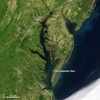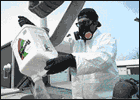
Joseph Nigro's team incorporated two NASA products into the Better Assessment Science Integrating Nonpoint Sources program that calculates streamflow rates and pollution concentrations.

EPA has published industry information on 2009 emissions the same month that the information was collected.
The team, which also includes Arkema, is trying to improve the efficiency and test new refrigerants in an air conditioner that runs on waste heat or solar heat.
Windy Point/Windy Flats project in Klickitat County, Wash., received a $200 million cash grant through the American Recovery and Reinvestment Act.
Researchers suggest invasive species may have altered Lake Erie's foodweb, where increasing concentrations of mercury have been found in walleye.
Computed tomography scans help scientists uncover damage to Diploastrea heliopora in the Red Sea caused by warm sea surface temperatures.
Stonington will upgrade its Mystic Water Pollution Control Facility with a process developed by Cambridge Water Technology.
The method is a low-cost environmentally friendly treatment option to remove various pollutants, according to the Water Research Foundation.
Operations Manager Dave Yungermann won the random drawing for employee contributors and will make a field visit to Bolivia to see the organization at work.
The updated TCR would establish criteria for systems to qualify for and stay on reduced monitoring.
The World Resources Institute analysis claims that existing authorities could gear up to meet the Obama Administration’s emissions reduction target “in the range of” 17 percent below 2005 levels by 2020.

Sustainability initiatives require a clear, steadfast plan.
The company is offering the service to health care providers because multiple doses of the vaccine contain enough mercury-based Thimerosal to be treated as a hazardous waste.
The Chemical Safety Board completed its report on the 2009 explosion at Veolia ES Technical Solutions' plant in Ohio and recommended the Center for Chemical Process Safety revise control room siting guidelines.
Proprietary technology is shown to be suitable for commercial LEDs in disinfection applications.
Champion Chemical, Imperial Oil and two former Imperial company officers will pay more than $1 million to satisfy the companies' obligations set forth in a 2001 consent decree.
The project will bring Carrizo Aquifer Supply to San Antonio, enough water for 40,000 households per year.
The rural electric cooperative, which will upgrade controls at two coal-fired plants in Indiana, will pay a $950,000 penalty and spend $5 million on environmental projects.